How To Build Attic Stair Cover | Big Energy Savings
Attic Stair Cover
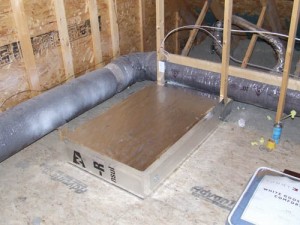 Insulated attic stair covers can reduce your heating and cooling energy consumption drastically.
Insulated attic stair covers can reduce your heating and cooling energy consumption drastically.
If you have an attic access hatch or a set of pull down attic stairs chances are good that you also have a tremendous amount of heat loss through that opening. We all know that heat rises and we all know that any opening to the outside will allow warm air to escape and cold air to enter our homes. Most people never think to check that old dusty attic access to see if it is properly insulated. In fact, most access hatches are located in a closet or out of site so we naturally forget about them.
Typically there are two types of hatches. One would be some type of plat panel door resting on top of trim or moulding. To access the attic you push the plat panel up into the attic. Therefore this type of panel rests on top of the moulding. The second most common type is a set of pull/fold down stairs. The “door” for this type of access is spring loaded and closes from the finished side up against the trim of the stairs.
Fall is a great time to install an attic stair cover. Building your own attic stair cover is really easy to do and costs about half what a store bought version will cost.
Standard Attic Stair Covers
There are certainly lots of different attic stair covers on the market if you want to buy one. Standard attic stair covers will work on most any attic stair unless you have a unique situation like our house. If you’re interested in buying an attic stair cover then check out the following link:
I think the manufactures of these attic stair covers are a bit misleading. Although the product claims and R50 insulating value I find that hard to believe when you see that the sides are not insulated. However, the standard attic stair covers are quick and easy to install.
DIY Attic Stair Cover
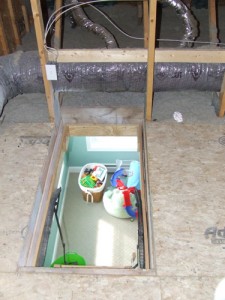 For our attic I needed a more flexible attic stair cover design so I decided to build my own. I want an attic stair cover that’s insulated on all four sides and the top.
For our attic I needed a more flexible attic stair cover design so I decided to build my own. I want an attic stair cover that’s insulated on all four sides and the top.
Because I want an attic stair cover that is insulated on all four sides I needed to come up with a unique design. As you can see from the adjacent photo our attic stair is adjacent to the edge of the vertical truss members. This creates a challenge because I cannot install the attic stair cover on top of the plywood sub-floor all around four sides.
So I decided to build my attic stair cover in two pieces, one piece is somewhat permanent and the other is removable. The first piece of the attic stair cover is installed between the truss members while the second piece installs over the plywood sub-floor and overlaps the first piece.
DIY Attic Stair Cover Materials
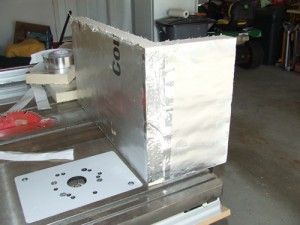 To build the attic stair cover I decided to use two inch thick foil faced foam board by DOW – TUFF-R. The TUFF-R has an R value of 13 (for 2 inches) and a foil facing which works great as a radiant heat barrier as well. The foil faced insulation board is also really easy to connect to other pieces using foil tape. The insulation is also really easy to cut with a table saw or utility knife.
To build the attic stair cover I decided to use two inch thick foil faced foam board by DOW – TUFF-R. The TUFF-R has an R value of 13 (for 2 inches) and a foil facing which works great as a radiant heat barrier as well. The foil faced insulation board is also really easy to connect to other pieces using foil tape. The insulation is also really easy to cut with a table saw or utility knife.
Our attic stair already has a layer of R6 foil faced factory installed on it. So our total R 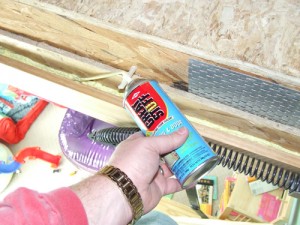 value will be R19 (I may add some more in the future if I decide to bump up the R value).
value will be R19 (I may add some more in the future if I decide to bump up the R value).
Insulate / Seal Opening First
Before I began working on the attic stair cover I wanted to be sure the attic stair frame was properly sealed and insulated. Attic stairs are installed in a rough openening, shimmed and fastened in place. The shims leave a large void that should be sealed. I like to use Great Stuff Foam insulation in a can to seal voids like this.
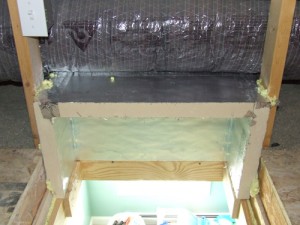
Custom Piece
First I installed a custom piece of attic stair cover. Because of our truss geometry I needed to create a smaller insulated box between the trusses and just past them by a couple inches. I built a three sided box, taped all the corners and then foamed it (Great Stuff Spray Foam) into the opening as you can see in the adjacent photo.
Insulated Attic Stair Cover Box
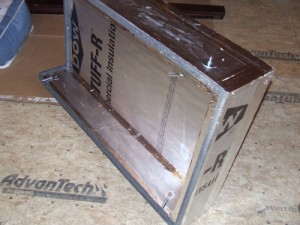 Finally I made the main insulated attic stair box cover. I made the box wider than the custom piece so it would fit over the first box. I also made the box wider and longer than the attic stair opening so that I could install weather stripping on the bottom to create a tight seal.
Finally I made the main insulated attic stair box cover. I made the box wider than the custom piece so it would fit over the first box. I also made the box wider and longer than the attic stair opening so that I could install weather stripping on the bottom to create a tight seal.
I built the box by taping together the pieces. The foil tape sticks VERY well to the foil faced insulation which creates a very strong box. I also installed 1/2 inch thick self-adhering weather stripping to the bottom edge and along the sides that overlap the custom piece.
Connecting Attic Stair Cover
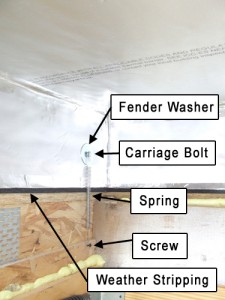 Finally I came up with a connection detail to hold the attic stair cover in place and also create a tight seal. I installed four bolts in the corners of the box. I used 3 inch long carriage bolts with large fender washers. The carriage bolts are nice because they stand off the fender washer as you can see in the photo.
Finally I came up with a connection detail to hold the attic stair cover in place and also create a tight seal. I installed four bolts in the corners of the box. I used 3 inch long carriage bolts with large fender washers. The carriage bolts are nice because they stand off the fender washer as you can see in the photo.
Next I bought some 3 inch long springs. I connected the springs to the carriage bolt on the box and a screw that I installed on the attic stair frame. As you can see I was able to put a good amount of tension on the springs which applies pressure to the attic stair cover which creates a good seal.
Attic Stair Cover Cost
The whole project cost about $30 for materials and took about 2 hours to complete. Even though the store bought attic stair covers boast an R value of 50 I doubt that’s the case based on the lack of side insulation. At least my DIY attic stair cover has insulation on all four sides and a nice tight seal.













That is a fantastic idea. Thanks for sharing that.
I saw something like this in the SkyMall catalog for way too much money, so I went home and built something nearly identical to what you built. But I didn’t use the carriage bolt/spring setup you have. And because all I’m using to compress the black adhesive weather stripping is gravity, it’s falling off at some places. So I’m going to add those springs tomorrow after a trip to Lowes.
Great idea.
Thank you for your article. I have been looking at home improvement stores and the internet for weeks. Every thing cost too much and I doughted a lot of the claims as you did. Your step by step guide was great and the pictures helped a lot. I know what to look for now at the store and it won’t be factory made.
Terry
North Carolina
@ Terry – Thanks for the compliments. That’s why I write these articles. Good luck!
Very nicely done… I really like the spring idea and will copy that part too!
I also note that you have about the best attic flooring I’ve ever seen–Advantech. The stuff is virtually indestructible. Is there a reason you chose this for attic flooring over other far cheaper means?
@ Scott – Thanks for the compliment. I chose AdvanTech because it does last forever. We built this home to be one we end up retiring in. I also bought full clips of AdvanTech at a reduced price so it just made sense.
Todd,
This is a great alternative to those expensive ready made ‘tents’. I want to build one but can not locate the TUFF-R product which I really like the look of. I’ve checked with the popular home improvement stores but – nothing. Any ideas?? I’m in Charlotte,NC.
Thanks!
@ Jim – Most lumber yards typically carry some type of foil faced foam board. If you can’t find that then I suggest using regular foam board. Tyvek tape adheres VERY well to foam board so I think you can still make it work. Good luck!
Love the carriage bolt and spring addition – nicely done sir!
Rob – It turned out pretty good. It was a bit of a challenge because of how close the truss member was. All things considered it works great!
Great idea! I’ve had a piece TUFF-R laying around, leftover from another project, just the right size I can use for a similar cover. In my case I don’t have pull-down stairs but just a simple attic hatch (scuttle door) that’s extra-leaky. I may be able to add a cover to the well the hatch is installed in. May even be able to make the cover flip aside like you did, we’ll see.
Just a quick note based on experience working with TUFF-R on another project outside of its normal use (long story): it is a tough material indeed if you spread any forces acting on it alongside the surface. In places where the force is concentrated (like the bottom side of the spring-loaded carriage bolt in your case) it’s going to give out sooner or later because the cells of the foam will collapse. It’s only holding any pressure well if it’s applied perpendicular to the surface, and preferably from the foiled side in. So, in your case you’d have to use a longer spring that would extend to the top board instead of the side one and then use an eye bolt with a largest fender washer you can find for the side opposite to the spring.
Anyways, great idea!
Cheers!
So far the bolts are working great. In fact, the large (2″ diameter) fender washers are likely the reason. The washers help spread the load to a much larger surface.
Well done. You need to teach me how you put the captions in that pic
I’ve seen the foam box on other sites, but keeping it sealed tight was the one piece that was missing. The bolts and springs are ingenious. Thanks for Sharing.
One additional thing I’ll be doing is adding some batt insulation to it as well. I will almost never be going up my attic stairs, so if it adds some extra weight no big deal for me.
Thanks for the post. Maybe it’s my tired eyes, but for me the pictures were too small (and maybe too few) for me to get the full idea of some of the things you did. But it gives me some inspiration.
I just have a square hole in my ceiling to cover better, where a whole house fan has been located (removed for the winter). No pull-down stairs. So hopefully I can determine a better way to seal for heat retention.
Thank you for this post! I am going to do this for the stairs I just installed. Nice job, and very creative.
Just wondering what your thoughts are on using magnetic tape on the floor and cover for the seal.
Cool idea!
Great post! I am doing a similar project in my home with pull down stairs. Good to see I am headed in the right direction. I am using 2” unfaced foam board which is rated at R-10. The side walls of the hatch are doubled up 4” wide for an R-20 value. I will be blowing 10-12” of cellulose in the attic which will be resting directly next to the hatch walls. The hatch itself will be triple layered for R-30 due to my attic scheduled to be around R-45 to R-50 once I blow the insulation. I think a hatch thicker than 6” will be cumbersome to use when trying to store things on the raised attic platform I built. Any thoughts on this?
Sounds pretty decent, it will make a big difference.
Thanks for your work documenting and explaining this project! Our old house has some small odd shaped accesses and this DIY is exactly what the house-doctor ordered